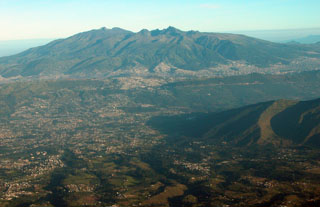Report on Guagua Pichincha (Ecuador) — December 1998
Bulletin of the Global Volcanism Network, vol. 23, no. 12 (December 1998)
Managing Editor: Richard Wunderman.
Guagua Pichincha (Ecuador) Phreatic discharges and shallow, near-vent seismicity continue
Please cite this report as:
Global Volcanism Program, 1998. Report on Guagua Pichincha (Ecuador) (Wunderman, R., ed.). Bulletin of the Global Volcanism Network, 23:12. Smithsonian Institution. https://doi.org/10.5479/si.GVP.BGVN199812-352020
Guagua Pichincha
Ecuador
0.171°S, 78.598°W; summit elev. 4784 m
All times are local (unless otherwise noted)
As late as 16 January, the volcanic crisis near Ecuador's capital, Quito, continued as visually observed activity and seismic indices showed little sign of either halting or escalating. Relevant histograms showing the seismic indices were posted by the Instituto Geofísico, Escuela Politécnica Nacional (IG-EPN) on their website. In addition to photos and regular updates, the site discusses such topics as civil defense and hazard planning. The current eruptive crisis began when a series of modest phreatic eruptions followed the large 4 August earthquake that struck near the coast ~175 km SW (BGVN 23:08 and 23:09). This summary covers the interval 28 October 1998-16 January 1999.
Summit observations on 27 October disclosed fumaroles off-gassing at both the 1981 crater and the adjacent 1998 crater, and steam wafting to 300 m. The last few days of October were marked by comparative quiet, with few phreatic eruptions, and associated tremor under 30 minutes in duration.
On 9 November seismically detected explosions reached a new high of 4/day; the previous maxima occurred when 3/day took place on two days in mid-October. During 22 November through 22 December instruments detected very few explosions. A visit to the crater area on 20 November disclosed abundant fresh debris on the rim, and numerous impact craters scattered about the area. Poor weather prohibited systematic determination of ash plume heights, but on 23 December one plume rising to 3 km altitude was seen from Quito. Explosions then resumed, with three explosions on 10 January. Patterns in the number of daily multiphase, long-period, and volcano-tectonic earthquakes were somewhat similar, with lows in the weeks surrounding 28 November and significant upswings thereafter. Many seismic events were shallow, at depths of several kilometers. Intervals of spasmodic tremor up to two or three hours also occurred during the reporting interval.
Scientists computed reduced displacements of the seismically detected explosions. For the following intervals the maxima can be summarized as follows: November, 14.8 cm2; December, 15 cm2; and 1-16 January, 13.3 cm2. Two so-called "tornillo" (screw-type) seismic events were noted on 3 January. The term arises from the seismic record of these events that looks like the profile of a screw. The broad, higher amplitude portion of the screw occurs early in the arrival sequence; the signal's amplitude decays slowly, finally reaching background at the point of the screw.
On 13 November field workers observed deposits from mud and debris flows that had come down the Cinto and Cristal rivers on 4 November. Triggered by a small rockslide on the SW flank, these flows were also seen by WSW-flank inhabitants who reside in the village of La Playa. The flows could be observed up to 15 km from the crater. The flow material also mixed with thin ash produced during phreatic explosions.
On 19 November a guard at a local refuge reported an absence of activity at both the crater and fumaroles; however, at 1049 that day, the fumarole known as 'La Locomotora,' located on the caldera's S wall, expelled vapor reaching 400 m high. This fumarole remained active throughout the reporting period. Another fumarole, known as Las Alineadas, escaped from the S dome area and was briefly mentioned on several days during mid-December as the source of sulfurous gases and loud noises; on 26 December Alineadas discharged an 800-m-tall vapor plume. On 13, 14, and 16 January crater fumaroles gave off vapor plumes that reached 1 km in altitude.
Press reports. An unusually clear, though undated photo of the two intracaldera craters can be found at the El Comercio website. The same site has over 70 articles (in Spanish) devoted to Guagua; pieces that are direct, practical, informative, and—given the circumstances—surprisingly upbeat. They convey a sense of the human side of a volcanic crisis without undue sensationalism. Topics include: broccoli growth in the volcano's soil, the vulnerability of a local marketplace in the event of an eruption, "Geophysicists—the volcano doctors," "Gasoline: there is a distribution plan," and the merging of art and science in an attempt to glean past eruptive behavior.
One article, titled "Guagua: mud and ash could effect 31,000," discusses the poor state of roofs in 18 separate zones in N upland areas along the E half of Quito's urban margins, an area described as high-risk. An impressive figure illustrates the locations and names of the zones, their populations, and shows how each ranks in terms of relative risk from mud flows and ash fall. Finally, for each of these zones, the figure indicates the average estimated risk of roofs to weight-bearing loads.
Geological Summary. Guagua Pichincha and the older Pleistocene Rucu Pichincha stratovolcanoes form a broad volcanic massif that rises immediately W of Ecuador's capital city, Quito. A lava dome grew at the head of a 6-km-wide scarp formed during a late-Pleistocene slope failure ~50,000 years ago. Subsequent late-Pleistocene and Holocene eruptions from the central vent consisted of explosive activity with pyroclastic flows accompanied by periodic growth and destruction of the lava dome. Many minor eruptions have been recorded since the mid-1500's; the largest took place in 1660, when ash fell over a 1,000 km radius and accumulated to 30 cm depth in Quito. Pyroclastic flows and surges also occurred, primarily to then W, and affected agricultural activity.
Information Contacts: Instituto Geofísico, Escuela Politécnica Nacional, Apartado 17-01-2759, Quito, Ecuador; El Comercio newspaper, Quito, Ecuador (URL: http://www.elcomercio.com); El Universo newspaper, Quito, Ecuador (URL: http://www.eluniverso.com).

